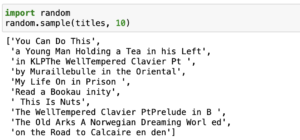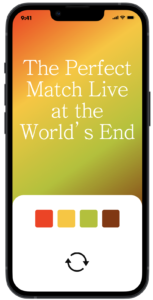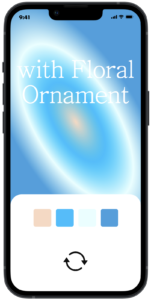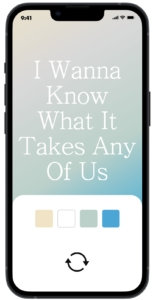Premise
Using Artificial Intelligence technology to help artists who are feeling creatively blocked.
Synopsis
Creative block is an issue experienced by many artists. It is characterized by an inability to create for reasons other than a lack of skill and is often accompanied by feelings of anxiety, frustration, and confusion. Despite the prevalence of this phenomenon among artists, it remains understudied in literature, and few solutions have been proposed. Artists have made countless contributions to our culture and society, so it is important to give them the tools that would help them beat creative block and stimulate their creativity. One possible solution could be the use of AI technology. Artificial intelligence could be used to generate a large number of novel ideas, which artists could use as a starting point for their work. For this project, I developed a prototype of an app that generates both visual and written ideas and tested its effectiveness with artists.
Substantiation
Creative block has been defined as an inability for an artist to begin or continue working for reasons other than a lack of basic skill or commitment (Rose, 1984, p. 3). The phenomenon of creative block affects all artists – individuals who engage in the creative process and generate new works (Haller & Courvoisier, 2010). Hence, in this project, any individual who produces new works such as visual art, writing, etc., will be considered an artist. Because an inability to create can occur for a variety of reasons, creative block is more of a catch-all term for many experiences (Gallay, 2013). Therefore, creating a prototype that solves every occurrence of it would be extremely challenging. However, it is reasonable to believe that a tool generating novel ideas could help the artists who either have a lack of ideas or are overwhelmed with selecting one idea out of many.
Artificial Intelligence was chosen for this project because it can enhance human abilities in every stage of the creative process (Wu et al., 2021). Especially in the stage of coming up with ideas, Artificial Intelligence could help artists think deeper and wider, and lead to unexpected accomplishments, because they wouldn’t be limited by their own minds (Wu et al., 2021). Within the field of Artificial Intelligence, Machine Learning technology specifically has the potential to help stimulate creativity – a machine learning AI could be fed vast amounts of data and then provide an artist with many starting points for their art (Magalhães, 2019, as cited in Soltanifar et al., 2021). This could be helpful to artists experiencing a creative block, as they would not be limited by their own ideas and could translate the ideas of an AI into works of art instead (Magalhães, 2019, as cited in Soltanifar et al., 2021).

The specific machine learning technology chosen for this prototype is the Python tool aitextgen. Several different text-generating Python packages have been tested, and aitextgen worked the best for this project. It allows the user to fine-tune a pre-trained GPT-2 model from OpenAI with their own data and includes functions that allow the user to modify the parameters of the generated text (Woolf, 2021).
Iteration 1
The first iteration was a neural network trained on a database of titles from The Met Museum. The neural network was created using a Python library aitextgen in a Google Colaboratory notebook. The neural network was trained for 3000 steps, with a learning rate of 1e-3. The model was used to generate a database of thousands of titles, which was saved in a .csv format. To test the prototype with users, a simple interface was created.

The first iteration was tested with artists working in various fields, such as painting and poetry, whether professionally or not. The users were given a few randomly selected generated titles in a simple interface and were asked to use one of them to create an artwork. They were then asked a few questions about their experience using the prototype, and their experience with creative blocks.

Based on their answers, it could be concluded that a tool such as this could play a role in beating creative block. The users described feeling frustrated, angry, and sad when experiencing a creative block. Most of them needed a few hours to a few weeks to get out of it, and many looked for inspiration from external sources during that time. In contrast, while using the prototype most of them were able to choose an idea very quickly and had fun. Many mentioned that the suggestions were something they wouldn’t have thought of themselves, which they found inspiring. A few suggested expanding the database of titles. One participant suggested she’d like to see a visual component next to a title, such as a color palette.
Iteration 2
The next iteration was developed based on the results of the first user test. The goal of this iteration was to expand the database of generated titles. Therefore, the neural network was trained on a wider variety of artwork titles – more artworks from The Met Museum and a database of song titles from Spotify. This was a challenging process, as the model trained on a bigger database started generating nonsensical texts full of letters and symbols. The model started performing better after deleting symbols and some of the most commonly occurring words from the initial database. However, it still generated some nonsensical titles, so it will need to be improved in the future.

The next user test was developed to test the expansion of the database and whether personalizing the titles for each user would be helpful or harmful, since previous participants mentioned that they liked the “unexpectedness” of the titles. The participants were asked to use an interface in Figma. First, they saw titles that were chosen completely randomly and were asked to use one of them to create an artwork. Then they saw titles that were hand-picked for each participant based on their interests and were asked to use one of them to create an artwork. They were asked questions about their experience.

From the test, it is safe to conclude that the expansion of the database was successful since each of the participants found the titles they wanted to use very quickly. However, no conclusion can be made on the personalization aspect. The participants were split evenly on whether they preferred the first or second option. Overall, both options were found to be helpful. The experiment would have to be repeated with a bigger sample size to come to a definite conclusion.



Prototypes shown in the user test
Iteration 3
This iteration was based on the suggestion from the first user test where the user proposed including a visual element such as a color palette. First, a random sample of (not nonsensical) generated titles was chosen. Then, a GPT3 Color Palette Generator was used to create a palette based on each of the titles (Richman, 2022). Both the titles and the colors the AI associated with them were then put into an interface in Figma.

A user test was conducted to determine whether the addition of the colors would be helpful. The participants were shown an equal number of suggestions with a palette and without and had to pick one to create an artwork. Two thirds of the participants chose a suggestion with a palette and a third said that visuals are likely to spark their imagination. Some participants described the prototype as calm, intuitive, and inspiring, while others were confused by what it does at first. Based on these results, explanations of the features will be added, and the color palettes will be kept in the interface.









Examples with color palettes
Conclusion
This tool was developed to help artists stimulate their creativity by using Artificial Intelligence. Based on the tests conducted, it is safe to say that such technology could indeed be useful to artists – all the participants except for one were able to create something based on the generated titles in every test. In most cases, they found a title that sparked their creativity quickly and found the process inspiring, calm, and fun, which is the opposite of the feelings usually experienced during a creative block. There is a lot of room for improvement of the prototype. The AI model needs to be functioning better so it will generate fewer nonsensical suggestions. The interface needs to be less confusing. A way for users to give feedback on the suggestions should be developed. I will work on improving all these aspects in the next iterations.
References
Gallay, L. H. (2013). Understanding and Treating Creative Block in Professional Artists. Alliant International University, California School of Professional Psychology. https://www.proquest.com/openview/5ea89bd126977a5c0f0a02d7cb152e07/1?pq-origsite=gscholar&cbl=18750
Haller, C. S., & Courvoisier, D. S. (2010). Personality and thinking style in different creative domains. Psychology of Aesthetics, Creativity, and the Arts, 4(3), 149–160. https://doi.org/10.1037/a0017084
Richman, D. (2022, March 9). Free GPT3 Colour Palette Generator. Richman SEO Training. https://www.seotraininglondon.org/free-gpt3-colour-palette-generator-v1/
Rose, M. (1984). Writer’s block : the cognitive dimension. Southern Illinois University Press.
Soltanifar, M., Hughes, M., & Göcke, L. (2021). Digital Entrepreneurship. Impact on Business and Society. In Future of Business and Finance. Springer International Publishing. https://doi.org/10.1007/978-3-030-53914-6
Woolf, M. (2021, April 29). aitextgen. GitHub. https://github.com/minimaxir/aitextgen
Wu, Z., Ji, D., Yu, K., Zeng, X., Wu, D., & Shidujaman, M. (2021). AI Creativity and the Human-AI Co-creation Model. Human-Computer Interaction. Theory, Methods and Tools, 171–190. https://doi.org/10.1007/978-3-030-78462-1_13